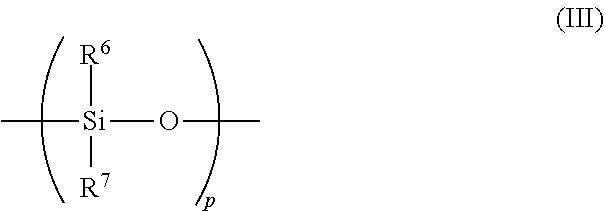Inkjet recording ink composition, method for producing the same, and inkjet recording method
a technology of inkjet recording and composition, which is applied in the direction of inks, instruments, measurement apparatus components, etc., can solve the problems of printing printed materials that have insufficient water resistance or solvent resistance, and inkjet recording mediums that are not easily infiltrated by inks compared to uncoated paper, etc., to achieve excellent water resistance and solvent resistance, excellent storage stability and ejection stability, and excellent solvent resistance
- Summary
- Abstract
- Description
- Claims
- Application Information
AI Technical Summary
Benefits of technology
Problems solved by technology
Method used
Image
Examples
preparation example 1
Preparation of Pigment Dispersion P-1
[0163]The same procedures as those described in Kieczykowski at al., J. Org. Chem., 1995, Vol 60, P. 8310 to 8312 and U.S. Pat. No. 4,922,007 were used to produce a [2-(4-aminophenyl)-1-hydroxyethane-1,1-diyl]bisphosphonic acid sodium salt. First, a 500 mL three-neck flask was equipped with a condenser provided with a gas outlet at the top thereof, a thermometer, a dry nitrogen introduction port, and a 100 mL equalizing dropping funnel. First, 32 g of phosphorous acid (380 mmol) and 160 mL of methanesulfonic acid (solvent) were added to this flask. To the stirred mixture, 57.4 g of aminophenylacetic acid (380 mmol) was added little by little. The stirred mixture was heated at 65° C. for 1 to 2 hours to dissolve the solid completely. The whole system was flushed with dry nitrogen and the temperature of the system was dropped to 40° C. after the solid was completely dissolved. To the heated solution, 70 mL of PCl3 (800 mmol) was gradually added thr...
preparation examples 2 to 5
Preparation of Pigment Dispersions P-2 to P-5
[0166]Each of a yellow Pigment dispersion P-2, a blue Pigment dispersion P-3, and a black Pigment dispersion P-4 was obtained in the same manner as in Preparation Example 1 except that, instead of PR122 of Preparation Example 1, each of C.I. Pigment Yellow 74 (PY74), C.I. Pigment Blue 15:4 (PB15:4), and carbon black (Black Pearls (registered trade mark) 700 carbon black (manufactured by Cabot Corporation)) were used, respectively.
[0167]Furthermore, for a Pigment dispersion P-5, a sulfo group-treated self-dispersion type pigment “CAB-O-JET (registered trade mark) 740Y” was used.
preparation example 6
Preparation of Pigment Dispersion P-6
[0168]In 80.1 g of ion exchange water, 3.0 g of a styrene-acrylic acid based polymer dispersing agent (“Joncryl 682” manufactured by BASF Japan, weight average molecular weight of 1,700, and acid value of 238 mg KOH / g) and 1.1 g of N,N-dimethyl-2-aminoethanol were dissolved. After adding 15 g of PR122 and 0.1 g of an antifoaming agent (“Surfynol 104E” manufactured by Air Products and Chemicals, Inc.), they were dispersed by a paint shaker using zirconia beads to obtain a red Pigment dispersion P-6. Incidentally, the styrene-acrylic acid based polymer dispersing agent is not an emulsion and it has a property that is different from that of the resin having a low acid value of the present invention.
PUM
| Property | Measurement | Unit |
|---|---|---|
| acid value | aaaaa | aaaaa |
| boiling point | aaaaa | aaaaa |
| boiling point | aaaaa | aaaaa |
Abstract
Description
Claims
Application Information
 Login to View More
Login to View More - R&D
- Intellectual Property
- Life Sciences
- Materials
- Tech Scout
- Unparalleled Data Quality
- Higher Quality Content
- 60% Fewer Hallucinations
Browse by: Latest US Patents, China's latest patents, Technical Efficacy Thesaurus, Application Domain, Technology Topic, Popular Technical Reports.
© 2025 PatSnap. All rights reserved.Legal|Privacy policy|Modern Slavery Act Transparency Statement|Sitemap|About US| Contact US: help@patsnap.com



